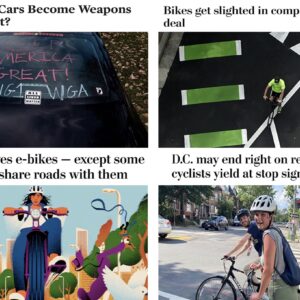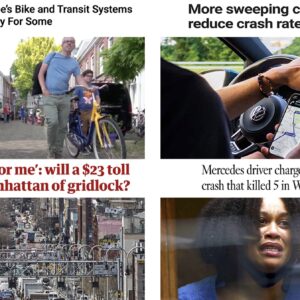“…these data suggest that warning patients who are medically unfit to drive may reduce the risk of road crashes…”
— Statement by researchers at Sunnybrook Health Sciences Centre
Here’s the news and other interesting stuff that caught our eyes this past week…
– Local Portland businessman Chris King recently visited the White House to talk about the current state of domestic manufacturing.
– The Atlantic Cities shares the story of Em Baker, who is riding across the country with two friends to bring attention to “pointless bike deaths.”
– Transportation Secretary Ray LaHood probably should go back and check his numbers after he misquoted a statistic about pedestrian injuries by blaming 80% of victims in fatal accidents involving someone walking across a street.
– Robert Marchand, a French centenarian, is the first in his age bracket to be officially recognizedby bicycling’s international governing body for riding a metric century.
– A three-foot passing law failed for the second time in California thanks to Governor Jerry Brown.
– The New York Times Sunday Review included a solid article on helmet use; after the author’s perspective on wearing one shifted significantly following a ride on Paris’ Velib bike share system.
– Bicycling for transportation is up a whopping 26% in Vancouver, BC over the last three years, compared with only a 10% increase in motor vehicle use and 6% population growth over the same period.
– Protected bike lanes appear to be gaining mainstream acceptance as one major car company now features a complete street in one of their ads.
– An interesting article from New York City which delves into the question of how better bike access relates to questions of equity and race.
– People who ride a bike for transportation in Toronto, Canada are feeling doubly-insulted by the city’s decision to use funds from the city’s budget for bicycle improvements to remove a new and well-traveled bike lane on Jarvis Street.
– It’s been a little while since we checked in with our friends in the Windy City, but it looks like Chicago is due for a number of improvements to bicycle access, including new bike share stations, bike corrals, and even a compact street sweeper to clean protected bike lanes.
– Cargo bikes are continuing to replace fossil fuel-powered delivery vehicles in major cities in Europe, creating “ever more jobs” for people “with strong cycling legs.”
– Of course riding a cargo bike might not take as much strength as you think according to this look at the physics of riding heavy bicycles, which borrows data on riding bikes from local bike shop Clever Cycles.
– Someone has once again debunked the notion that bike lanes increase costs for people driving cars by showing how encouraging bicycling for transportation benefits everyone in Vancouver, BC.
– If last week you saw the article that explains “why you hate cyclists” you might want to check out this response discussing what some feel the original article got right, and what it got wrong.
– Along with Jonathan’s look back at Critical Mass over 20 years, the San Francisco Chronicle has their own retrospective.
– Students from London’s Royal College of Art created the Velopresso, an espresso machine on a cargo trike.
– There’s a handy (and entertaining) guide on “spotting different species of bicyclists” from The Wall Street Journal which includes a nod to our hometown friends, Portland Design Works.
– Specialized has issued a recall of 12,000 men’s and women’s Globe model bicycles from 2008 and 2009 due to faulty front forks.
– Venerable news magazine The Economist is the latest to examine the drop in motor vehicle travel in industrialized countries including the United States.
– Doctors in Ontario, Canada are confronting patients who are unfit to drive due to a medical limitation. Their efforts appear to have resulted in a drop in collision rates.
– If you weren’t able to attend Interbike this year, there’s a thorough convention roundup with great pictures from The Path Less Pedaled‘s Russ Roca.
– And finally, speaking of Interbike, if you missed the new gear on display this year you can still have a look at this video showcasing the Xtracycle EdgeRunner:
— Did you find something interesting that should be in next week’s Monday Roundup? Drop us a line. For more great links from around the web, follow us on Twitter @BikePortland.





Thanks for reading.
BikePortland has served this community with independent community journalism since 2005. We rely on subscriptions from readers like you to survive. Your financial support is vital in keeping this valuable resource alive and well.
Please subscribe today to strengthen and expand our work.
Irksome. (on the LaHood quote above) Why does NYC’s LOOK campaign direct pedestrians but not those driving to LOOK when entering a cross walk?
It’s just a big pile of troll and linkbait, but one of the opening lines from this OregonLive blog guest opinion piece is too priceless to miss:
“And while this opinion is not a critique of same-sex marriage, there is something in common there with sharing the public roads […]”
Yup, they went there.
But the comments are mostly sane, thank goodness.
I am surprised they didn’t also propose banning same-sex marriage on “at least some main thoroughfares, downtown streets and bridges.”
Did Extracycle get it ‘Right’ with their Edgerunner with trailer?
After viewing their promo film…I wonder: perhaps it would have been better for rearward visibility (using a helmet mirror) if the trailer had been placed on the other side of the bike. The portage of tall items, such as the bamboo in the video highlight this traffic safety issue – reduced rearward vision.
it goes on either side…
Solid NY Times Sunday Review article on bike helmets? Rosenthal missed the biggest reason that European cyclist don’t wear helmets– protected bikeway infrastructure. Until US cities have a robust network of protected bikeways, I’ll always wear a helmet in this country.
Well he did mention ‘mature cycle infrastructure’ several times, and from biking in Germany both in the eighties and more recently I can assure you that most lane miles are not protected. Sure there is some infrastructure in cities that would be considered protected, but that doesn’t cover most of the country’s streets and roads.
If we’re looking for *one* thing that is materially different for biking in Europe vs here (besides the strength in numbers issue) I’d think driver education and awareness would be near the top of the list. But there are also a host of laws, greater overlap between drivers and bicyclists, lower speed limits in town, etc.
I usually wear my helmet, too. Mostly because if I get hit by a car, it has a magical power to protect me from the driver’s insurance company and any from the non-bike media who would doubtlessly do everything possible to make it look like my fault. In this culture, apparently, “no helmet” means “suicidal miscreant who will not rest until he has found a completely innocent bystander to maim and kill him”.
I love that we’re all so focused on helmets that we never bother learning how to ride safely. Cycling is no safer than Hang-Gliding! Protect your head! Maybe we can use the word “helmet” to educate people on actual bike safety.
HELMET! Now that I have both your attention and a fear-based response, here’s how you can actually ride a bike safely:
HELMET! Ride on the right side of the street. Wouldn’t it be nice if this was the first violation PDX cops would enforce?
HELMET! Get off the damn sidewalk. You’re going to hurt someone.
HELMET! Stop for cross-traffic. I could care less who rolls through an empty intersection, but when others are approaching? Never mind the danger element. It’s a D**k move.
HELMET! Use lights that you can actually see with. Flashers are for low-visibilty daylight. In the dark, your 2000-lumen front strobe is blindingly inconsiderate of approaching traffic, and it doesn’t show you that new pothole or the streetcar track that now, neither of us can see. Use your solid beam after sunset.
HELMET! Stop drafting off of random people. Seriously. You are not “racing”. I don’t know why we do this. What would you do if a stranger walked up behind you on the sidewalk and slid his hand into your crack? Someone is eventually going to brake-check you into the curb and u-lock your neck to your down tube.
here’s the author’s response to the comments posted:
elisabeth rosenthalnew york
Thanks for all the passionate comments. I want to respond to the many readers who said: “Sure I’d do this in Europe, but never in the U.S.” The reason I re-thought helmets in Paris is that Paris was NOT a bicycling city before Velib came along. It was similar to New York in many ways. Paris was not Copenhagen or Amsterdam, which each had a long history of bike commuting.
A successful bike sharing program in Paris changed the way Parisians get around their city and drew thousands of new people on to bikes, with all of the general health benefits. That also changed the power balance between cars and bikes. It changed the demographic of who rides bikes around the city and, with that, changed the speed of cyclists (slower). Also, with so many people riding, it is easier for a city to justify improving the network of safe bike lanes.
But I am still wearing a helmet in New York today…
Regarding the passing law, I’d like to point out that Oregon’s passing law is pointless 99% of the time. It’s really a sick joke designed to placate people who don’t read the fine print.
Read it and think about how it applies to most city riding. It doesn’t. It only applies if the cars are going OVER 35mph and there is no bike lane.
I’d rather have NO law than this joke. It leads people to believe that they are somehow protected when they aren’t which keeps us from talking about what we need.
http://www.stc-law.com/SafePassing.html
You can thank Tri-Met for the 35mph part of that law.
I can tell you from California that NO law isn’t always so fun, but then again most traffic laws are a joke. People drive based on their perception of the law(s) anyway – and police detectives process scenes that way too. I’ve always said that rationalization is one of the highest powers of the human mind…
Brown should ride with me sometime. He’d learn there are many cyclists on the roads in California, and drivers frequently pass them over solid lines (as well as other cars). Unfortunately it seems there are more lawyers here than cyclists though.
Unlike the first time around, this revised bill had majority support!
I hate to rain on the cargo bike parade but weight has a HUGE impact on pedaling effort in hilly cities like Portland. If you are going up a 5% grade, weigh 180 pounds and are riding a 20 or 60 pound bike almost all your energy is used to overcome gravity, not overcome air resistance or rolling resistance. In the example in the article someone measured the speed of the bicycles going up a 5% grade with the same 160W of rider power. The 20 pound bicycle did 7.2 mph while the 60 pound bicycle did 6.1 mph. Of that 160W, 143W were used to overcome gravity leaving 17W left over for all other drag for the 20 pound bicycle with a 180 pound rider. For the 60 pound bicycle and a 180 pound rider 146W were used to overcome gravity with 14W left for all other drag. Even at 2% grades you have to be going around 25 mph before aerodynamic drag is higher than overcoming gravity. So, while aero drag may be very important on level ground, on any uphill weight more important.
Of course you need to keep in mind the weight you need to worry about is both the rider and the bike so if the rider weighs 300 pound, the difference between a 20 pound bicycle and 60 is only around 10% more effort to go up a hill. For a 180 pound rider, a 60 pound bicycle would be about 20% harder to get up a hill than a 20 pound bicycle.
Yeah my ‘bar bike’ is a 1980-ish Schwinn Traveler and weighs, somehow, a tad over 40 lbs. The frame is supposedly steel, but I think they were actually using lead.
It feels much harder to ride than my fancy-pants road bike, which is only in the 18-19 lb range. Not to mention I use clipless on that bike and have spent a lot of time ‘tweaking it’ to fit well. But by comparison, it feels as if it moves forward under almost no power.
My schwinn feels as if it’s fighting me the whole way. I did the 40 mile bridge pedal on it once, no way I’d feel like doing that now.
The pullquote at the top:
“…these data suggest that warning patients who are medically unfit to drive may reduce the risk of road crashes…”
does this refer to any of the articles discussed in today’s roundup? Because the link in the quote takes one to a researcher’s website.
Thanks for catching that! I’ve corrected the link in the quote and re-added a line about the original article from NPR.